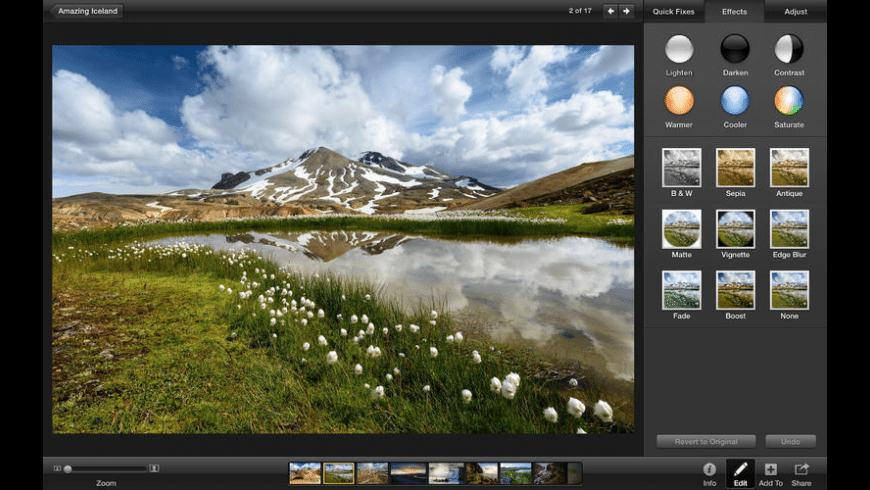iCloud Drive is a secure place to access all of your photos, videos and documents from Mac, Windows PC and iOS device. It allows you to store any type of file in your account. There is no restriction on file type, so you can keep all of your photos, videos, projects, presentations and more across all of your devices. To do so, you need to enable iCloud on all your devices.

Here are the steps to Transfer Photos and Videos from iPhoto to iCloud Drive on Mac:
- Open 'iPhoto' on your Mac.
- Select photos and videos which you want to transfer.
- Click 'File' tab.
- Select 'Export' option.
- A 'Export' window opens up.
- Select the file type in Kind, File Name, Subfolder Format and more.
- Click 'Export' button.
- Choose 'iCloud Drive' folder.
- This way you can transfer photos and videos from iPhoto to iCloud Drive on Mac.
Iphoto 10.7 5 Download
Photos are precious memories and all of us never want to ever lose them to hard disk crashes or missing drives. PicBackMan is the easiest and simplest way to keep your photos safely backed up in one or more online accounts. Simply download PicBackMan (it's free!), register your account, connect to your online store and tell PicBackMan where your photos are - PicBackMan does the rest, automatically. It bulk uploads all photos and keeps looking for new ones and uploads those too. You don't have to ever touch it.- Not content to merely update its flagship mobile operating system, Apple on Wednesday released three significant updates for Mac users: Mac OS X 10.7.2, Lion Recovery Update, and iPhoto 9.2.
- Apple Iphoto Os X free download - Apple Mac OS X Mavericks, Apple Java for OS X 10.6, Apple Mac OS X Snow Leopard, and many more programs. Apple Mac OS X Lion 10.7.5 Supplemental Update.
Iphoto will not work Version 9.4.3 all i get is To open your library with this version of iPhoto, it first needs to be prepared. MacOS is 10.7.5:confused.

Reader Celia Drummond had a Mac crash so severe, she had to upgrade her system from Mavericks to El Capitan—I didn’t ask about Sierra—although she was able to recover her data from Time Machine.
However, after using the iPhoto Library Upgrader, Apple’s recommended path for converting iPhoto 7 and earlier libraries to a newer format that iPhoto 8 and 9 can use, “The result is photos a fraction of their original size—most were between 1MB and 7MB each—and all are pixelated.”
I never used the utility, so I don’t know what went wrong, but something did if that’s the outcome, or something is missing in the Time Machine backup. Because she can’t run the older version of iPhoto, she can’t simply rebuild the library, which is the usual suggestion. (I’d make sure you had version 1.1 via the link above, as older versions are out there, too.)

I’d normally suggest for forward version compatibility to try to find an intermediate version of software, which has been useful for folks with various older releases of the iWork suite (Pages, Numbers, and Keynote). However, the only course of action with an iPhoto 7 library is apparently to run it through the upgrader; you can’t just try to open it in iPhoto 8 (or 9). (I don’t have older libraries to check this out, so I’m relying on Apple and forum posters.)
If the upgrader just won’t work with the old library, the only real solution is to crack open the library and extract ones photos.
- Control-click the iPhoto Library.
- Choose Show Package Contents from the contextual menu.
- Drag (to move) or Option-drag (to copy) the Masters folder to the Desktop or to another drive.
- Launch the latest version of iPhoto 9 and import that Masters folder. Or launch Photos and do the same.
Unfortunately, you’ll lose a lot of information associated with photos and video that’s stored within the library, such as metadata, potentially some edits, albums, and other organizational elements. But this is better than losing the high-resolution versions of your media.
After importing the images and videos and making sure they’re the high-resolution ones you want, you can then use a de-duplication program, like PowerPhotos or Photosweeper 3 (review coming), which can clean up the low-resolution images and possibly help fix the missing metadata.
Ask Mac 911
Iphoto 10.7 5 Full
We’ve compiled a list of the questions we get asked most frequently along with answers and links to columns: read our super FAQ to see if your question is covered. If not, we’re always looking for new problems to solve! Email yours to mac911@macworld.com including screen captures as appropriate. Mac 911 can’t reply to—nor publish an answer to—every question, and we don’t provide direct troubleshooting advice.